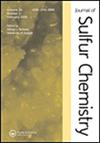DFT, TD-DFT, QTAIM and NBO investigations of the interaction between sulfur mustard and metal porphyrins induced in carbon nanocone (M-PCNC, M = Fe2+ and Mg2+)
IF 1.6
3区 化学
Q3 CHEMISTRY, MULTIDISCIPLINARY
引用次数: 0
Abstract
In this study, the adsorption behavior of sulfur mustard on metal porphyrins replaced in carbon nanocone (M-PCNC, M = Fe2+ and Mg2+) is explored using density functional theory (DFT) calculations. Energetics, physical parameters, and electronic properties are determined utilizing the M06-2X approach and the 6-31G(d) basis set. Based on the obtained results, the sulfur mustard exhibits strong adsorption onto the M-PCNCs, which denotes a chemisorption process between species. Furthermore, the findings suggest that the M-PCNCs are effective adsorbents in eliminating undesired sulfur mustard molecules from the surroundings. The data also show that the energy gap (or work function) of the M-PCNC structures is not affected by the adsorption of sulfur mustard, suggesting that they are unsuitable for use as sensors for the sulfur mustard in terms of electronic conductivity or work function. The UV-visible spectra of bare Fe-PCNC are also compared to its corresponding complexes, which reveals the adsorption of sulfur mustard does not alter the spectra of the Fe-PCNC and cannot act as a UV-based sensitive material for detecting sulfur mustard.
碳纳米锥(M- pcnc, M = Fe2+和Mg2+)中硫芥与金属卟啉相互作用的DFT、TD-DFT、QTAIM和NBO研究
本文利用密度泛函理论(DFT)研究了硫芥在碳纳米锥(M- pcnc, M = Fe2+和Mg2+)金属卟啉上的吸附行为。利用M06-2X方法和6-31G(d)基准集确定能量学、物理参数和电子特性。结果表明,芥菜在M-PCNCs上表现出较强的吸附作用,表明存在种间的化学吸附过程。此外,研究结果表明,M-PCNCs是一种有效的吸附剂,可以从周围环境中去除不需要的芥子气分子。数据还表明,M-PCNC结构的能隙(或功函数)不受芥菜吸附的影响,这表明它们在电子电导率或功函数方面不适合用作芥菜传感器。对裸态Fe-PCNC的紫外可见光谱与相应配合物的紫外可见光谱进行了比较,结果表明,对芥菜的吸附不会改变Fe-PCNC的光谱,不能作为检测芥菜的紫外敏感材料。
本文章由计算机程序翻译,如有差异,请以英文原文为准。
求助全文
约1分钟内获得全文
求助全文
来源期刊

Journal of Sulfur Chemistry
CHEMISTRY, MULTIDISCIPLINARY-
CiteScore
4.10
自引率
9.10%
发文量
38
审稿时长
6-12 weeks
期刊介绍:
The Journal of Sulfur Chemistry is an international journal for the dissemination of scientific results in the rapidly expanding realm of sulfur chemistry. The journal publishes high quality reviews, full papers and communications in the following areas: organic and inorganic chemistry, industrial chemistry, materials and polymer chemistry, biological chemistry and interdisciplinary studies directly related to sulfur science.
Papers outlining theoretical, physical, mechanistic or synthetic studies pertaining to sulfur chemistry are welcome. Hence the target audience is made up of academic and industrial chemists with peripheral or focused interests in sulfur chemistry. Manuscripts that truly define the aims of the journal include, but are not limited to, those that offer: a) innovative use of sulfur reagents; b) new synthetic approaches to sulfur-containing biomolecules, materials or organic and organometallic compounds; c) theoretical and physical studies that facilitate the understanding of sulfur structure, bonding or reactivity; d) catalytic, selective, synthetically useful or noteworthy transformations of sulfur containing molecules; e) industrial applications of sulfur chemistry; f) unique sulfur atom or molecule involvement in interfacial phenomena; g) descriptions of solid phase or combinatorial methods involving sulfur containing substrates. Submissions pertaining to related atoms such as selenium and tellurium are also welcome. Articles offering routine heterocycle formation through established reactions of sulfur containing substrates are outside the scope of the journal.
 求助内容:
求助内容: 应助结果提醒方式:
应助结果提醒方式:


